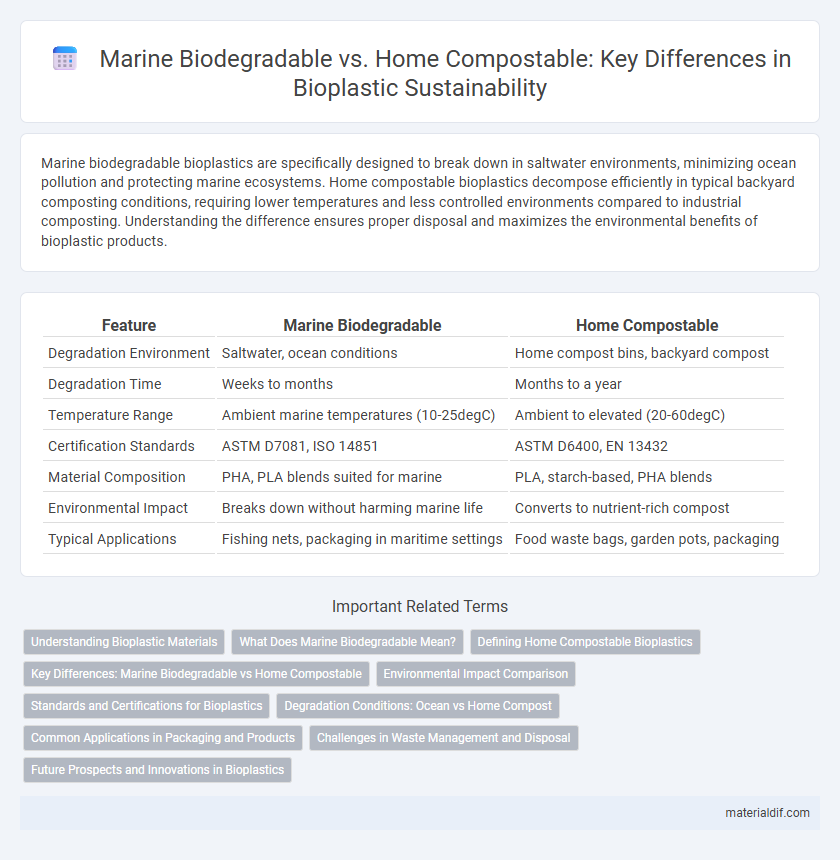Marine biodegradable bioplastics are specifically designed to break down in saltwater environments, minimizing ocean pollution and protecting marine ecosystems. Home compostable bioplastics decompose efficiently in typical backyard composting conditions, requiring lower temperatures and less controlled environments compared to industrial composting. Understanding the difference ensures proper disposal and maximizes the environmental benefits of bioplastic products.
Table of Comparison
| Feature | Marine Biodegradable | Home Compostable |
|---|---|---|
| Degradation Environment | Saltwater, ocean conditions | Home compost bins, backyard compost |
| Degradation Time | Weeks to months | Months to a year |
| Temperature Range | Ambient marine temperatures (10-25degC) | Ambient to elevated (20-60degC) |
| Certification Standards | ASTM D7081, ISO 14851 | ASTM D6400, EN 13432 |
| Material Composition | PHA, PLA blends suited for marine | PLA, starch-based, PHA blends |
| Environmental Impact | Breaks down without harming marine life | Converts to nutrient-rich compost |
| Typical Applications | Fishing nets, packaging in maritime settings | Food waste bags, garden pots, packaging |
Understanding Bioplastic Materials
Marine biodegradable bioplastics are designed to break down in ocean environments through natural microbial activity, minimizing marine pollution and protecting aquatic ecosystems. Home compostable bioplastics decompose efficiently in domestic composting conditions, typically breaking down within 90 days without leaving harmful residues. Understanding the specific degradation requirements and certifications of bioplastic materials helps in selecting the appropriate product for environmental sustainability.
What Does Marine Biodegradable Mean?
Marine biodegradable bioplastics are designed to break down in oceanic environments through the action of marine microorganisms, preventing long-term pollution in seas and oceans. These materials decompose under specific conditions such as saltwater presence, varying temperatures, and microbial activity unique to marine ecosystems. Marine biodegradability certification ensures that the bioplastic fragments into natural elements without leaving toxic residues harmful to marine life.
Defining Home Compostable Bioplastics
Home compostable bioplastics break down efficiently in residential composting environments, typically within 90 days, under moderate temperature and humidity conditions. These materials are certified to decompose without leaving harmful residues, making them suitable for everyday organic waste disposal. Unlike marine biodegradable bioplastics designed for ocean environments, home compostable bioplastics require specific composting conditions found in household compost bins rather than natural water bodies.
Key Differences: Marine Biodegradable vs Home Compostable
Marine biodegradable bioplastics break down efficiently in seawater, typically within months, without releasing harmful microplastics, making them ideal for reducing ocean pollution. Home compostable bioplastics require specific temperature and humidity conditions found in home composting setups to decompose fully within a few weeks to months, ensuring safe integration into garden soil. The key difference lies in their decomposition environments and timelines, with marine biodegradable suited for aquatic ecosystems and home compostable designed for terrestrial organic waste management.
Environmental Impact Comparison
Marine biodegradable bioplastics break down efficiently in ocean environments, significantly reducing marine pollution and protecting aquatic ecosystems by minimizing microplastic accumulation. Home compostable bioplastics decompose in controlled domestic compost settings, lowering landfill waste and enhancing soil health without releasing harmful residues. Comparing environmental impacts, marine biodegradable options offer superior benefits for ocean conservation, while home compostables excel in supporting sustainable waste management on land.
Standards and Certifications for Bioplastics
Marine biodegradable bioplastics must comply with standards such as ASTM D7081 and ISO 18830, ensuring degradation in seawater within specific timeframes while minimizing environmental impact. Home compostable bioplastics require certifications like EN 13432 and ASTM D6400, indicating their ability to break down efficiently at lower temperatures typical of domestic composting systems. These certifications guarantee product performance and environmental safety, guiding manufacturers and consumers in sustainable bioplastic choices.
Degradation Conditions: Ocean vs Home Compost
Marine biodegradable bioplastics degrade in ocean environments through the action of saltwater, microbial communities, and lower temperatures, often taking months to years depending on material composition. Home compostable bioplastics transform into organic matter within household compost systems at higher temperatures, typically between 20degC and 30degC, supported by active microbial activity and oxygen availability, usually within 6 to 12 months. Differences in degradation conditions such as salinity, temperature, and microbial population directly impact the breakdown rates and environmental compatibility of bioplastics in marine versus home compost settings.
Common Applications in Packaging and Products
Marine biodegradable bioplastics are designed to break down in saltwater environments, making them ideal for applications such as fishing gear, marine packaging, and single-use items discarded in oceans. Home compostable bioplastics decompose effectively under typical residential composting conditions, making them suitable for food packaging, disposable tableware, and biodegradable bags used in everyday household waste. Both types contribute to reducing plastic pollution, but their effectiveness depends on the disposal environment and product design.
Challenges in Waste Management and Disposal
Marine biodegradable bioplastics face challenges in waste management due to slower degradation rates in cold, saline ocean environments and limited industrial infrastructure for large-scale marine disposal. Home compostable bioplastics require specific temperature and microbial conditions often absent in natural soil or landfill settings, leading to incomplete decomposition and potential microplastic accumulation. Both types necessitate advanced sorting technologies and public education to prevent cross-contamination with conventional plastics and ensure proper end-of-life processing.
Future Prospects and Innovations in Bioplastics
Marine biodegradable bioplastics are engineered to break down efficiently in ocean environments, offering potential solutions for reducing marine pollution from plastic waste. Home compostable bioplastics are designed to decompose in domestic composting conditions, promoting sustainable waste management at the consumer level. Innovations in bioplastics are focusing on enhancing material properties, accelerating degradation processes in diverse environments, and developing hybrid polymers that combine marine biodegradability with home compostability for broader ecological impact.
Marine biodegradable vs Home compostable Infographic

 materialdif.com
materialdif.com